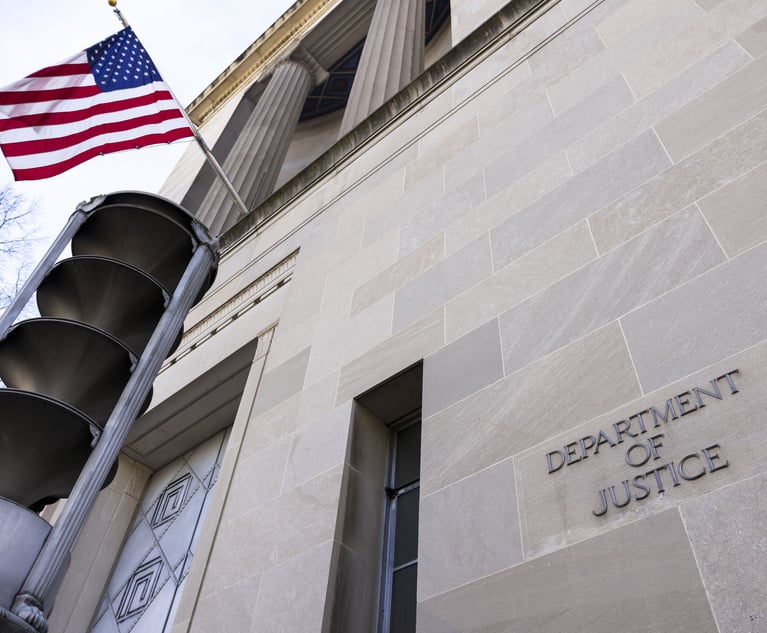Sedona Conference Cautions Against Siloed Approach to Information Governance
In an update to its 2014 information governance guide, the Sedona Conference advises organizations to be unified in how to govern information to better protect themselves against risks and runaway costs.
April 17, 2019 at 12:30 PM
3 minute read
The original version of this story was published on Legal Tech News

Last week, the Sedona Conference released an update to 2014's “The Sedona Conference Commentary on Information Governance.” The report stressed veering from a siloed approach to information governance to a company-wide collaborative process.
“Knowingly or not, organizations face a fundamental choice: They can control their information, or, by default, they can allow their information to control them,” the report cautioned. It added that inefficiently controlled data can be a “dangerous” source of risk and liability or cause increased costs.
Traditionally, individual departments have governed information in a way that results in decisions being made without sufficient consideration of information value, risk or compliance for the organization, according to the report. Such an approach results in duplicate technology and unneeded expenses and ultimately prevents the efficient sharing of information.
In an effort to break that common occurrence, Sedona updated its information governance commentary and explained how the traditional approach has prevented a more adequate consideration of data.
In its principles for information governance, Sedona outlines various elements of an effective program. Those principles include representing all stakeholders' views and needs in the program; effectively, timely and consistently disposing of information that's no longer needed; leveraging technology; and considering data privacy and security as well as risk management and sound business practices.
Cheryl Strom, records information manager of a global company's workplace information management and office services and drafting team leader of the Sedona Conference report, noted support from the C-suite is also vital for successfully implementing a company-wide information governance program.
“It's important to have that sponsorship from that level. That way, employees will be more apt to comply and more on board with following an information governance program or information governance policy,” she said.
After everyone has adopted the program, the company would have a framework for defensible disposition, and more reliable and efficient processes for e-discovery, audits and investigations, the report noted. Along with reduced storage costs and less administrative burdens, leaner storage also improves the accessibility and use of valuable information across an organization.
However, there can be hesitancy to adopt new information governance programs. Strom noted resistance to new policies could be stoked by reluctance to change or cost fears.
“I think there's resistance because of culture and the costs involved and resources required, she said. “But I think if we can emphasize the overall benefits of an information governance program, that can help to minimize the resistance and support of the program in an organization.”
This content has been archived. It is available through our partners, LexisNexis® and Bloomberg Law.
To view this content, please continue to their sites.
Not a Lexis Subscriber?
Subscribe Now
Not a Bloomberg Law Subscriber?
Subscribe Now
NOT FOR REPRINT
© 2025 ALM Global, LLC, All Rights Reserved. Request academic re-use from www.copyright.com. All other uses, submit a request to [email protected]. For more information visit Asset & Logo Licensing.
You Might Like
View All
Lawsuit Against Major Food Brands Could Be Sign of Emerging Litigation Over Processed Foods
3 minute read
Government Attorneys Face Reassignment, Rescinded Job Offers in First Days of Trump Administration
4 minute read
Law Firm Sued for $35 Million Over Alleged Role in Acquisition Deal Collapse
3 minute read
4th Circuit Upholds Virginia Law Restricting Online Court Records Access
3 minute readTrending Stories
- 1Cornell Claims AT&T, Verizon Violated the University's Wi-Fi Patents
- 2OCR Issues 'Dear Colleagues' Letter Regarding AI in Medicine
- 3Corporate Litigator Joins BakerHostetler From Fish & Richardson
- 4E-Discovery Provider Casepoint Merges With Government Software Company OPEXUS
- 5How I Made Partner: 'Focus on Being the Best Advocate for Clients,' Says Lauren Reichardt of Cooley
Who Got The Work
J. Brugh Lower of Gibbons has entered an appearance for industrial equipment supplier Devco Corporation in a pending trademark infringement lawsuit. The suit, accusing the defendant of selling knock-off Graco products, was filed Dec. 18 in New Jersey District Court by Rivkin Radler on behalf of Graco Inc. and Graco Minnesota. The case, assigned to U.S. District Judge Zahid N. Quraishi, is 3:24-cv-11294, Graco Inc. et al v. Devco Corporation.
Who Got The Work
Rebecca Maller-Stein and Kent A. Yalowitz of Arnold & Porter Kaye Scholer have entered their appearances for Hanaco Venture Capital and its executives, Lior Prosor and David Frankel, in a pending securities lawsuit. The action, filed on Dec. 24 in New York Southern District Court by Zell, Aron & Co. on behalf of Goldeneye Advisors, accuses the defendants of negligently and fraudulently managing the plaintiff's $1 million investment. The case, assigned to U.S. District Judge Vernon S. Broderick, is 1:24-cv-09918, Goldeneye Advisors, LLC v. Hanaco Venture Capital, Ltd. et al.
Who Got The Work
Attorneys from A&O Shearman has stepped in as defense counsel for Toronto-Dominion Bank and other defendants in a pending securities class action. The suit, filed Dec. 11 in New York Southern District Court by Bleichmar Fonti & Auld, accuses the defendants of concealing the bank's 'pervasive' deficiencies in regards to its compliance with the Bank Secrecy Act and the quality of its anti-money laundering controls. The case, assigned to U.S. District Judge Arun Subramanian, is 1:24-cv-09445, Gonzalez v. The Toronto-Dominion Bank et al.
Who Got The Work
Crown Castle International, a Pennsylvania company providing shared communications infrastructure, has turned to Luke D. Wolf of Gordon Rees Scully Mansukhani to fend off a pending breach-of-contract lawsuit. The court action, filed Nov. 25 in Michigan Eastern District Court by Hooper Hathaway PC on behalf of The Town Residences LLC, accuses Crown Castle of failing to transfer approximately $30,000 in utility payments from T-Mobile in breach of a roof-top lease and assignment agreement. The case, assigned to U.S. District Judge Susan K. Declercq, is 2:24-cv-13131, The Town Residences LLC v. T-Mobile US, Inc. et al.
Who Got The Work
Wilfred P. Coronato and Daniel M. Schwartz of McCarter & English have stepped in as defense counsel to Electrolux Home Products Inc. in a pending product liability lawsuit. The court action, filed Nov. 26 in New York Eastern District Court by Poulos Lopiccolo PC and Nagel Rice LLP on behalf of David Stern, alleges that the defendant's refrigerators’ drawers and shelving repeatedly break and fall apart within months after purchase. The case, assigned to U.S. District Judge Joan M. Azrack, is 2:24-cv-08204, Stern v. Electrolux Home Products, Inc.
Featured Firms
Law Offices of Gary Martin Hays & Associates, P.C.
(470) 294-1674
Law Offices of Mark E. Salomone
(857) 444-6468
Smith & Hassler
(713) 739-1250








